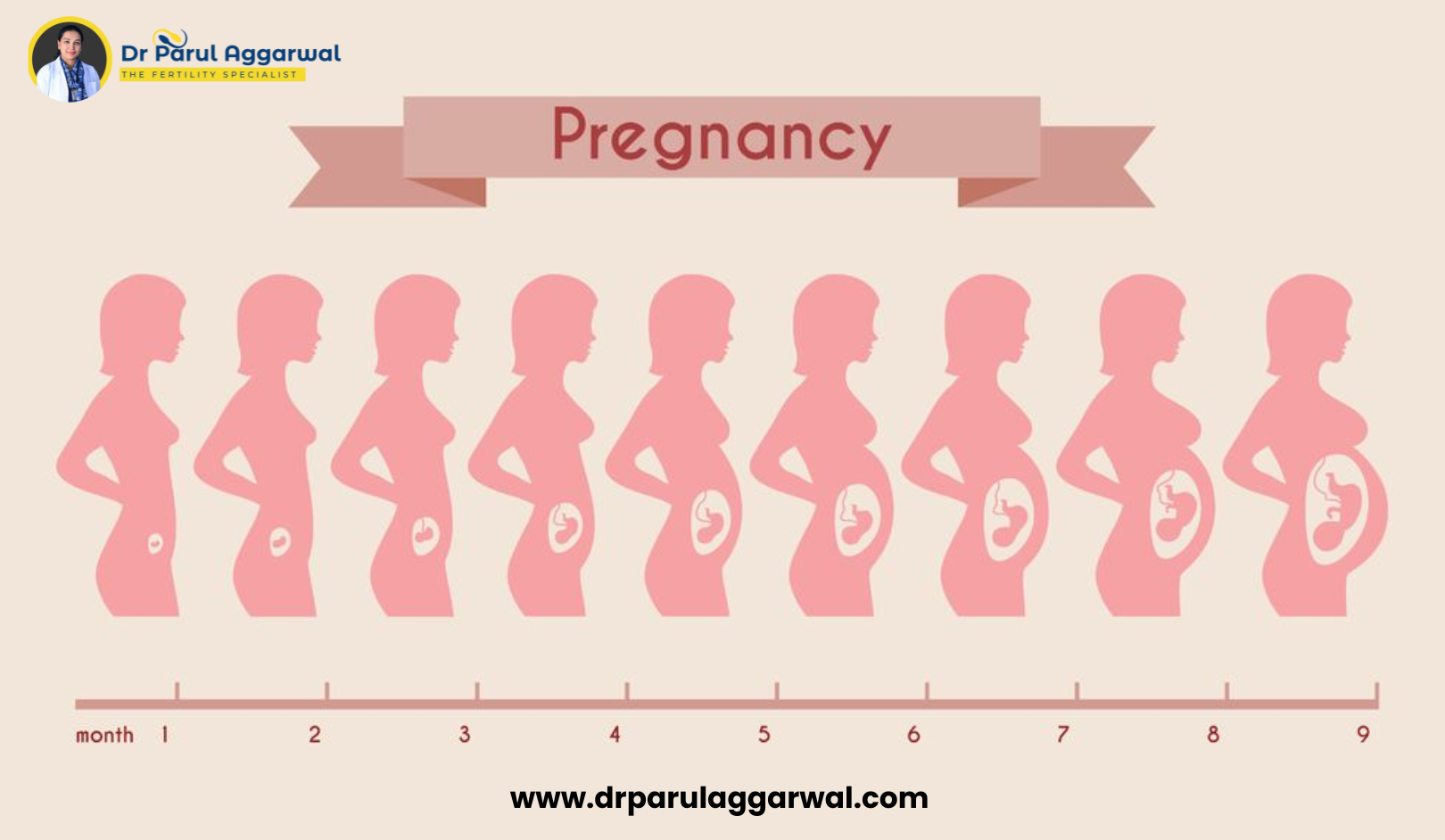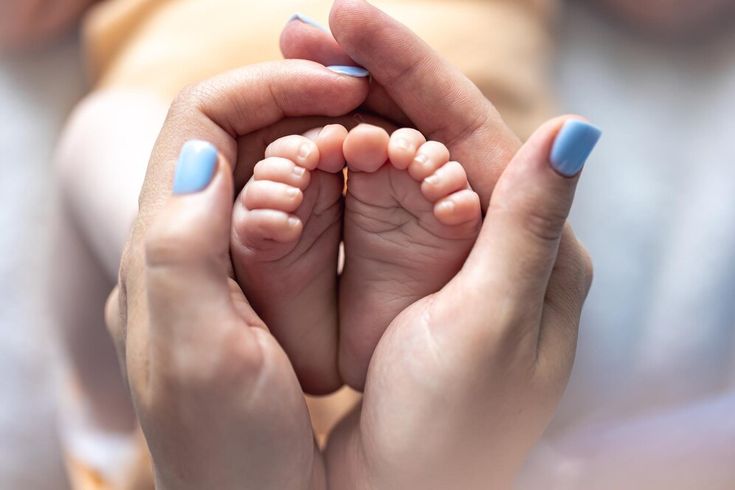Pregnancy is a fascinating journey marked by remarkable changes and developments, both for the expecting mother and the growing baby. One of the most exciting aspects of pregnancy is tracking your baby's growth month by month. Understanding these changes not only helps in appreciating the miracle of life but also aids in monitoring the health and development of the baby. Dr. Parul Aggarwal, a leading fertility specialist in Delhi, shares her insights into the month-by-month growth of a baby in the womb.
Month 1: The Beginning
Size and Development
In the first month of pregnancy, the baby is still an embryo. By the end of the first month, the baby is about the size of a poppy seed (around 1-2 mm).
- Development Milestones:
- Fertilization occurs, and the zygote forms.
- The zygote undergoes rapid cell division.
- The embryo implants itself into the uterine wall.
- The primitive placenta and amniotic sac begin to develop.
Month 2: Rapid Growth
Size and Development
By the second month, the baby grows to about the size of a raspberry (around 0.6 inches or 1.6 cm).
- Development Milestones:
- Major organs like the heart, brain, and spinal cord start forming.
- Facial features such as eyes, nose, and ears begin to develop.
- Limbs start to bud, and fingers and toes begin to form.
- The heartbeat can be detected via ultrasound.
Month 3: Transition to Fetus
Size and Development
At three months, the baby is roughly the size of a plum (about 2.5-3 inches or 6-7.5 cm).
- Development Milestones:
- The baby officially becomes a fetus.
- All major organs are present and start to function.
- Fingers and toes are fully formed, and nails start to develop.
- The baby starts to make spontaneous movements, although they are not yet felt by the mother.
Month 4: Active and Growing
Size and Development
By the fourth month, the baby grows to the size of an avocado (about 4.5 inches or 11 cm).
- Development Milestones:
- The baby’s skeleton starts to harden from cartilage to bone.
- Hair, eyebrows, and eyelashes begin to grow.
- The nervous system continues to develop, allowing the baby to make more coordinated movements.
- The baby can start to hear sounds from outside the womb.
Month 5: Halfway Mark
Size and Development
At five months, the baby is about the size of a banana (about 6.5 inches or 16 cm).
- Development Milestones:
- The baby starts to develop a sleep-wake cycle.
- Vernix caseosa, a greasy coating that protects the skin, forms.
- The baby’s movements, known as quickening, can be felt by the mother.
- The baby’s skin becomes less transparent as fat starts to accumulate.
Month 6: Increased Activity
Size and Development
By the sixth month, the baby grows to the size of a corn cob (about 12 inches or 30 cm).
- Development Milestones:
- The baby’s lungs start producing surfactant, which is essential for breathing after birth.
- The baby’s eyes start to open, and the baby can respond to light.
- The baby continues to gain weight and grow in length.
- The mother can feel stronger and more frequent movements.
Month 7: Gaining Strength
Size and Development
At seven months, the baby is about the size of a large eggplant (about 14-15 inches or 36-38 cm).
- Development Milestones:
- The baby’s brain undergoes rapid development.
- The baby’s body continues to accumulate fat, smoothing out the skin.
- The baby’s hearing is fully developed, and the baby can recognize the mother’s voice.
- The baby practices breathing movements, although the lungs are not fully developed.
Month 8: Nearly There
Size and Development
By the eighth month, the baby is about the size of a pineapple (about 17-18 inches or 43-46 cm).
- Development Milestones:
- The baby’s bones are fully developed but still soft and flexible.
- The baby’s skin becomes pinker and less wrinkled as fat continues to build up.
- The baby’s brain and nervous system continue to mature.
- The baby starts to position itself head-down in preparation for birth.
Month 9: Ready for Birth
Size and Development
At nine months, the baby is about the size of a watermelon (about 19-21 inches or 48-53 cm).
- Development Milestones:
- The baby’s lungs are fully developed and ready for breathing outside the womb.
- The baby’s reflexes, such as sucking and grasping, are fully developed.
- The baby continues to gain weight, which helps regulate body temperature after birth.
- The baby’s movements may decrease slightly as space becomes limited, but they should still be regular.
Importance of Prenatal Care
Throughout pregnancy, regular prenatal care is crucial for monitoring the baby’s development and ensuring the health of both mother and baby. Dr. Parul Aggarwal emphasizes the importance of:
- Regular Check-Ups: Frequent visits to the healthcare provider help track the baby’s growth and detect any potential issues early.
- Ultrasound Scans: Ultrasounds provide valuable insights into the baby’s development and help in identifying any abnormalities.
- Nutritional Guidance: Proper nutrition is vital for the baby’s growth and the mother’s health. A balanced diet rich in essential vitamins and minerals supports healthy development.
- Lifestyle Adjustments: Avoiding harmful substances, managing stress, and maintaining a healthy lifestyle contribute to a healthy pregnancy.
Common Questions and Concerns
1. How often should I have an ultrasound during pregnancy?
Routine ultrasounds are typically scheduled at 8-12 weeks, 18-20 weeks, and 32-34 weeks. However, your healthcare provider may recommend additional ultrasounds if necessary.
2. What can I do to support my baby’s development?
Maintaining a healthy diet, staying hydrated, getting regular exercise, and avoiding harmful substances like alcohol and tobacco can support your baby’s development.
3. Is it normal to feel anxious about my baby’s growth?
It’s common to feel anxious during pregnancy. Regular check-ups, clear communication with your healthcare provider, and staying informed about your baby’s development can help alleviate concerns.
4. What should I do if I notice a decrease in my baby’s movements?
If you notice a significant decrease in your baby’s movements, contact your healthcare provider immediately. They can perform tests to ensure your baby’s well-being.
Conclusion
Understanding your baby’s size and development month by month can enhance the joy and anticipation of pregnancy. Regular prenatal care, guided by experts like Dr. Parul Aggarwal, ensures that both mother and baby remain healthy throughout this remarkable journey. From the size of a poppy seed to a watermelon, each stage of development is a testament to the miracle of life. Embrace this journey with confidence and excitement, knowing that you are supported by experienced professionals dedicated to helping you achieve a healthy and successful pregnancy.

